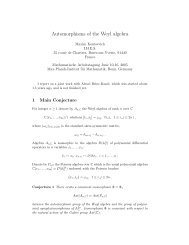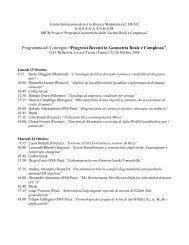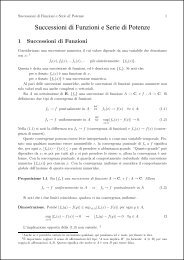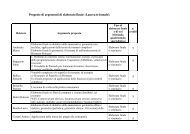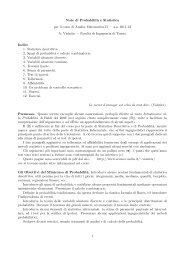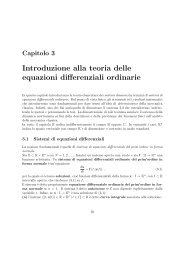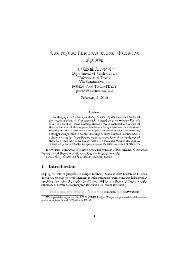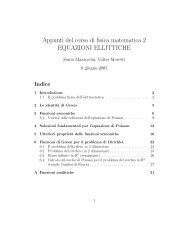Scritto del 13.7.2012 con la soluzione degli esercizi - Scienze ...
Scritto del 13.7.2012 con la soluzione degli esercizi - Scienze ...
Scritto del 13.7.2012 con la soluzione degli esercizi - Scienze ...
Create successful ePaper yourself
Turn your PDF publications into a flip-book with our unique Google optimized e-Paper software.
Geometria 2<br />
Università <strong>degli</strong> Studi di Trento<br />
Corso di Laurea in Matematica<br />
A.A. 2011/2012<br />
13 luglio 2012<br />
Si svolgano i seguenti <strong>esercizi</strong>.<br />
Esercizio 1. Sia P 3 (R) il 3–spazio proiettivo reale dotato <strong>del</strong> riferimento cartesiano<br />
standard di coordinate [x 0 , x 1 , x 2 , x 3 ]. Definiamo i punti A, B, C e D di<br />
P 3 (R) ponendo<br />
A := [1, −1, 0, 2], B := [1, 0, 1, 3], C := [1, 1, 2, 4], D := [1, −1, 2, 1].<br />
Si risponda ai seguenti quesiti:<br />
(1) Si dimostri che i punti A, B e C sono allineati e sia calcoli un sistema<br />
di equazioni cartesiane per <strong>la</strong> retta proiettiva di P 3 (R) passante per tali<br />
punti.<br />
(2) Si dimostri che il punto D non è allineato <strong>con</strong> A, B e C e si calcoli un’equazione<br />
cartesiana <strong>del</strong> piano proiettivo di P 3 (R) passante per A, B, C e<br />
D.<br />
Esercizio 2. Sia E 2 il piano euclideo numerico dotato <strong>del</strong> riferimento cartesiano<br />
standard di coordinate (x, y). Definiamo <strong>la</strong> <strong>con</strong>ica C di E 2 come<br />
C : x 2 + 4y 2 + 4xy − 6x + 1 = 0<br />
Si risponda ai seguenti quesiti<br />
(1) Si dimostri che C è una parabo<strong>la</strong>.<br />
(2) Si determini un’isometria diretta S : E 2 → E 2 di E 2 tale che S(C) = D e<br />
si calcoli l’asse di simmetria di C.<br />
Esercizio 3. Siano τ 1 , τ 2 le topologie su R definite da<br />
τ 1 = {(a, +∞) | a ∈ R} ∪ {R, ∅}, τ 2 = {(−∞, b) | b ∈ R} ∪ {R, ∅}<br />
(1) Si dica, motivando <strong>la</strong> risposta, se (R, τ 1 ) è compatto.<br />
(2) Si dica, motivando <strong>la</strong> risposta, se (R, τ 1 ) è di Hausdorff.<br />
(3) Si dica, motivando <strong>la</strong> risposta, se (R, τ 1 ) è <strong>con</strong>nesso.<br />
(4) Si provi che una funzione suriettiva f : (R, τ 1 ) → (R, τ 2 ) è un omeomorfismo<br />
se e solo se è strettamente monotona decrescente.<br />
Esercizio 4. Sia C = {(x, y) ∈ R 2 : x 2 + y 2 − 1 = 0} <strong>con</strong> <strong>la</strong> topologia indotta<br />
dal<strong>la</strong> topologia euclidea di R 2 e sia D = R/ ∼ <strong>con</strong> <strong>la</strong> topologia quoziente, dove ∼ è<br />
<strong>la</strong> re<strong>la</strong>zione di equivalenza<br />
Dimostrare che C e D sono omeomorfi.<br />
x ∼ y ⇐⇒ x − y ∈ Z.<br />
1
2<br />
Soluzioni<br />
¸ Esercizio 1.<br />
(1) Dobbiamo verificare che rk(M) = 2, dove<br />
⎛<br />
1 −1 0<br />
⎞<br />
2<br />
M := ⎝1 0 1 3⎠<br />
1 1 2 4<br />
Portando avanti il processo di eliminazione di Gauss, si ottiene che<br />
⎛<br />
⎞ ⎛<br />
⎞<br />
1 −1 0 2 1 −1 0 2<br />
⎝1 0 1 3⎠ → ⎝0 1 1 1⎠<br />
1 1 2 4 0 2 2 2<br />
da cui è evidente come <strong>la</strong> matrice M abbia rango 2.<br />
Calcoliamo ora un sistema di equazioni cartesiane per <strong>la</strong> retta r passante<br />
da A e B (e quindi da C):<br />
⎛<br />
x 0 x 1 x 2<br />
⎞<br />
x 3<br />
rk ⎝ 1 −1 0 2 ⎠ = 2<br />
0 1 1 1<br />
se e solo se<br />
⎧<br />
⎪⎨<br />
⎛<br />
⎞<br />
x 0 x 1 x 2<br />
⎜<br />
0 = det ⎝ 1 −1 0<br />
0 1 1<br />
⎟<br />
⎠ = −x 0 − x 1 + x 2<br />
.<br />
⎛<br />
⎞<br />
x 1 x 2 x 3<br />
⎜<br />
⎟<br />
0 = det ⎝−1 0 2 ⎠ = −2x 1 + 3x 2 − x 3<br />
⎪⎩<br />
1 1 1<br />
Si ottiene dunque l’equazione <strong>del</strong><strong>la</strong> retta:<br />
{<br />
−x 0 − x 1 + x 2 = 0<br />
r :<br />
−2x 1 + 3x 2 − x 3 = 0<br />
.<br />
(2) Dobbiamo verificare che rk(N) = 3, dove N per esempio è data da<br />
⎛<br />
1 −1 0<br />
⎞<br />
2<br />
N := ⎝1 0 1 3⎠ .<br />
1 −1 2 1<br />
Come prima, portando avanti il processo di eliminazione di Gauss, si<br />
ottiene ⎛<br />
⎞ ⎛<br />
⎞<br />
1 −1 0 2 1 −1 0 2<br />
⎝1 0 1 3⎠ → ⎝0 1 1 1 ⎠<br />
1 −1 2 1 0 0 2 −1<br />
<strong>la</strong> quale ha evidentemente rango 3.<br />
Per determinare un’equazione cartesiana <strong>del</strong> piano proiettivo π <strong>con</strong>tenente<br />
i punti A, B e D procediamo come segue:<br />
⎛<br />
⎞<br />
x 0 x 1 x 2 x 3<br />
det ⎜ 1 −1 0 2<br />
⎟<br />
⎝ 1 0 1 3 ⎠ = x −1 0 2<br />
0<br />
0 1 3<br />
∣−1 2 1∣ +<br />
1 −1 2 1
SOLUZIONI 3<br />
∣ ∣∣∣∣∣ 1 0 2<br />
−x 1 1 1 3<br />
1 2 1∣ + x 1 −1 2<br />
2<br />
1 0 3<br />
∣1 −1 1∣ − x 1 −1 0<br />
3<br />
1 0 1<br />
∣1 −1 2∣ =<br />
= 7x 0 + 3x 1 − x 2 − 2x 3<br />
e dunque l’equazione cartesiana <strong>del</strong> piano π diventa<br />
π : 7x 0 + 3x 1 − x 2 − 2x 3 = 0.<br />
¸ Esercizio 2.<br />
(1) Consideriamo le matrici associate al<strong>la</strong> <strong>con</strong>ica C date da<br />
⎛<br />
A = ⎝ 1 −3 0<br />
⎞<br />
( )<br />
−3 1 2⎠ 1 2<br />
, A 0 =<br />
2 4<br />
0 2 4<br />
Calcoliamo il determinante di A:<br />
∣ 1 −3 0<br />
∣∣∣∣∣ 1 −3 0<br />
−3 1 2<br />
∣ 0 2 4∣ = 0 −8 2<br />
= −32 − 4 = −36 ≠ 0<br />
0 2 4∣ La <strong>con</strong>ica C è dunque non degenere. Calco<strong>la</strong>ndo anche<br />
det A 0 = 4 − 4 = 0<br />
si dimostra che C è una parabo<strong>la</strong>.<br />
(2) Calcoliamo <strong>la</strong> forma canonica D di C.<br />
Partiamo calco<strong>la</strong>ndo una base ortonormale di R 2 diagonale per A 0<br />
e <strong>con</strong>cordemente orientata <strong>con</strong> quel<strong>la</strong> canonica di R 2 , in modo tale da<br />
eliminare il termine misto. Il polinomio caratteristico di A 0 è dato da<br />
( )<br />
1 − λ 2<br />
p(λ) = det<br />
= (1 − λ)(4 − λ) − 4 = λ(λ − 5)<br />
2 4 − λ<br />
Gli autovalori di A 0 sono dunque λ 1 = 0 e λ 2 = 5. I corrispondenti<br />
autovettori, già normalizzati, sono<br />
( )<br />
( )<br />
− √5 2 1√5<br />
v 1 := , v 1√ 2 :=<br />
√ 2 .<br />
5 5<br />
Controlliamo l’orientazione:<br />
det(v 1 v 2 ) =<br />
(<br />
−<br />
2 √5 1 √5<br />
1√<br />
5<br />
2 √5<br />
)<br />
= −1<br />
La base cercata è dunque B = (v 2 , v 1 ).<br />
Definiamo <strong>la</strong> matrice M ∈ SO(2) come<br />
( )<br />
1√5<br />
− √ 2<br />
M := 5<br />
2√ √5 1<br />
5<br />
La rotazione indotta da M è<br />
( ) (<br />
x1 x<br />
R : ↦→ = M<br />
y 1 y)<br />
(<br />
x1<br />
y 1<br />
)<br />
= √ 1 ( )<br />
x1 − 2y 1<br />
5 2x 1 + y 1
4<br />
Sostituendo nell’equazione di C troviamo l’equazione di R −1 (C), data da<br />
( 1<br />
0 = √5 x 1 − √ 2 ) 2 ( 2<br />
y 1 + 4 √5 x 1 + 1 ) 2<br />
√ y 1 +<br />
5 5<br />
( 1<br />
+4 √5 x 1 − √ 2 ) ( 2<br />
y 1 √5 x 1 + 1 ) ( 1<br />
√ y 1 − 6 √5 x 1 − 2 )<br />
√ y 1 + 1<br />
5 5 5<br />
Termini di se<strong>con</strong>do grado:<br />
1 (<br />
x<br />
2<br />
5 1 + 4y1 2 + 16x 2 1 + 4y1 2 + 8x 2 1 − 8y1) 2 1 ( )<br />
= 25x<br />
2<br />
5 1 = 5x<br />
2<br />
1<br />
Termini di primo grado:<br />
1<br />
√<br />
5<br />
(−6x 1 + 12y 1 )<br />
Quindi<br />
R −1 (C) : 5x 2 1 − 6 √<br />
5<br />
x 1 + 12 √<br />
5<br />
y 1 + 1 = 0<br />
Riscriviamo il termine in x 1 :<br />
(<br />
) ( ) 2<br />
5 x 2 1 − 6√ 5<br />
25 x 1 = 5 x 1 − 3√ 5<br />
− 9 25 25<br />
e dunque<br />
R −1 (C) : 5<br />
(<br />
x 1 − 3√ 5<br />
25<br />
) 2<br />
+ 12√ 5<br />
5<br />
y 1 + 16<br />
25 = 0<br />
che riscritta diventa:<br />
(<br />
R −1 (C) : 5 x 1 − 3 ) 2<br />
5 √ + 12 (<br />
√ y 1 + 4 )<br />
5 5 15 √ = 0<br />
5<br />
Definiamo l’isometria diretta T : E 2 → E 2 come<br />
( ) ( ) ( )<br />
x1 x2 x1 − 3<br />
T : ↦→ =<br />
5 √ 5<br />
y 1 y 2 y 1 + 4 .<br />
15 √ 5<br />
In questo modo, sostituendo, si ottiene l’equazione <strong>del</strong><strong>la</strong> forma canonica:<br />
D : 5x 2 2 + 12 √<br />
5<br />
y 2 = 0.<br />
Osservando i passaggi fatti, si ha D = T ◦ R −1 (C), ovvero S = T ◦ R −1 .<br />
Per ricavare l’equazione di S calcoliamo R −1 :<br />
( ( ) ( )<br />
R −1 x x1<br />
: ↦→ = M<br />
y)<br />
−1 x<br />
= 1 ( ) x + 2y<br />
√<br />
y 1 y 5 −2x + y<br />
e dunque S è dato da<br />
( x<br />
S : ↦→<br />
y)<br />
(<br />
x2<br />
)<br />
=<br />
y 2<br />
( )<br />
1√5<br />
x + √ 2 5<br />
y − 3<br />
5 √ 5<br />
− √ 2 5<br />
x + √ 1 5<br />
y + 4<br />
15 √ 5<br />
Poiché l’asse di simmetria di D è dato dall’equazione y 2 = 0, l’asse di<br />
simmetria di C è dato da<br />
−√ 2 x + √ 1 y + 4<br />
5 5 15 √ 5 = 0<br />
cioè<br />
−30x + 15y + 4 = 0.
SOLUZIONI 5<br />
¸ Esercizio 3.<br />
Rispondiamo per punti.<br />
(1) Consideriamo il seguente ricoprimento aperto di R:<br />
A = {(m, +∞) ⊂ R | m ∈ Z}.<br />
Chiaramente si ha<br />
R = ⋃ (m, +∞)<br />
m∈Z<br />
e quindi A costituisce un ricoprimento aperto di R. Da questo ricoprimento<br />
non è possibile estrarre un sottoricoprimento finito. Supponiamo infatti<br />
che, per assurdo, si abbia<br />
A 0 = {(m 1 , +∞), . . . , (m k , +∞)}<br />
un sottoricoprimento finito. Allora, posto m := min{m 1 , . . . , m k }, si ha<br />
⋃<br />
(m i , +∞) = (m, +∞) ≠ R<br />
i=1,...,k<br />
e siamo dunque giunti all’assurdo, in quanto tale A 0 non costituisce un<br />
ricoprimento di R.<br />
(2) Lo spazio (R, τ 1 ) non è Hausdorff in quanto non è mai possibile trovare<br />
aperti disgiunti in τ 1 . Di <strong>con</strong>seguenza, dati due punti distinti, non sarà<br />
mai possibile trovare due intorni distinti dei due punti, in quanto questi<br />
intorni sarebbero un esempio di due aperti disgiunti <strong>del</strong><strong>la</strong> topologia, cosa<br />
impossibile.<br />
(3) Per lo stesso motivo <strong>del</strong> punto precedente, lo spazio (R, τ 1 ) è <strong>con</strong>nesso.<br />
(4) Supponiamo f sia suriettiva e strettamente monotona decrescente e dimostriamo<br />
che f sia un omeomorfismo. Essendo strettamente monotona f è<br />
iniettiva. Dimostriamo che sia <strong>con</strong>tinua. Per <strong>la</strong> stretta monotonia si ha<br />
f −1 (−∞, b) = (f −1 (b), +∞).<br />
Infatti, usando <strong>la</strong> stretta monotonia e <strong>la</strong> biiettività, si ha<br />
x ∈ (f −1 (b), +∞) ⇐⇒ x > f −1 (b) ⇐⇒ f(x) < f(f −1 (b)) = b<br />
⇐⇒ f(x) ∈ (−∞, b) ⇐⇒ x ∈ f −1 (−∞, b).<br />
Ciò dimostra che f è <strong>con</strong>tinua. Per dimostrare che è un omeomorfismo,<br />
basta osservare che una funzione <strong>con</strong>tinua biiettiva strettamente monotona<br />
ha inversa anch’essa strettamente monotona e dunque, per quanto appena<br />
visto, anche f −1 risulta essere <strong>con</strong>tinua.<br />
Supponiamo ora che f sia un omeomorfismo. Ciò significa che<br />
f −1 (−∞, y) = (a y , +∞), f(x, +∞) = (−∞, b x )<br />
per ogni x e y reali. Essendo f biunivoca per ipotesi, basta dimostrare che<br />
f è monotona decrescente. Siano x 1 < x 2 due numeri reali e supponiamo<br />
per assurdo che f(x 1 ) < f(x 2 ). Definiamo<br />
m := f(x 1) + f(x 2 )<br />
2<br />
Allora, poiché f(x 1 ) < m, si ha<br />
e poiché x 2 > x 1 si ha anche<br />
∈ (f(x 1 ), f(x 2 )).<br />
x 1 ∈ f −1 (−∞, m) = (a m , +∞)<br />
x 2 ∈ (x 1 , +∞) ⊂ (a m , +∞) = f −1 (−∞, m)
6<br />
il che significa f(x 2 ) < m, un assurdo.<br />
¸ Esercizio 4.<br />
Sia π : R → D <strong>la</strong> proiezione naturale. Ricordiamo che<br />
Definiamo <strong>la</strong> mappa f : R → C come<br />
π −1 ([y]) = {y + k : k ∈ Z}.<br />
f(β) = (cos 2πβ, sin 2πβ).<br />
Per costruzione f è suriettiva, poiché per ogni (x, y) ∈ C esiste α ⊂ R tale che<br />
(x, y) = (cos α, sin α). Basta prender allora β = α/2π. Si ha quindi f(R) = C.<br />
La mappa f è anche <strong>con</strong>tinua. Sia infatti A un aperto in C. Posso supporre<br />
che A sia <strong>del</strong> tipo<br />
A = {(cos α, sin α) ∈ C : α ∈ (a, b)}.<br />
Allora <strong>la</strong> <strong>con</strong>troimmagine di A è data da<br />
f −1 (A) = ⋃ k∈Z(a + 2kπ, b + 2kπ),<br />
il quale è un aperto di R.<br />
Osserviamo che f è compatibile <strong>con</strong> <strong>la</strong> re<strong>la</strong>zione di equivalenza. Infatti<br />
f(β 1 ) = f(β 2 ) ⇐⇒ cos 2πβ 1 = cos 2πβ 2 ∧ sin 2πβ 1 = sin 2πβ 2<br />
⇐⇒ ∃k ∈ Z : 2πβ 1 = 2πβ 2 + 2kπ ⇐⇒ [β 1 ] = [β 2 ].<br />
Grazie a tutto questo, f passa al quoziente e si ha dunque una mappa<br />
f : D(= R/ ∼) → C,<br />
f([β]) = (cos 2πβ, sin 2πβ)<br />
ben definita, <strong>con</strong>tinua, iniettiva e suriettiva. Per mostrare che f è un omeomorfismo,<br />
basta <strong>con</strong>trol<strong>la</strong>re che che C sia di Hausdorff e che D sia compatto. La prima è<br />
immediata in quanto C ha <strong>la</strong> topologia indotta da quel<strong>la</strong> euclidea di R 2 , il quale è<br />
Hausdorff. Per mostrare che D è compatto si può osservare che<br />
D = R/ ∼ = [0, 1)/ ∼ = [0, 1]/ ∼ ,<br />
dove <strong>la</strong> prima uguaglianza deriva dal fatto che ogni c<strong>la</strong>sse di equivalenza ammette<br />
uno e un solo rappresentante in [0, 1) (in partico<strong>la</strong>re, [x] = [x − pt(x)], dove pt(x)<br />
denota <strong>la</strong> parte intera di x) mentre <strong>la</strong> se<strong>con</strong>da uguaglianza si ottiene osservando che<br />
[1] = [0]. Poiché [0, 1] è compatto, anche D è compatto e <strong>la</strong> dimostrazione è dunque<br />
<strong>con</strong>clusa.




